 \
&
Contact us
\
&
Contact us
 \
&
Contact us
\
&
Contact us
The Driving Urban Transitions is an co-funded partnership, bringing together private and public stakeholders in the research and innovation ecosystems. The DUT partnership incorporates all urban stakeholders (local authorities, municipalities, business and citizens) to co-create innovative, systemic and people-centric approaches, tools, methods and services in support of urban transformative transitions.
CET Partnership aims to achieve this through annual calls addressing three transition pathways, further divided in three themes:
There are two active Flemish participating members in the DUT call: Flanders Innovation & Entrepreneurship (VLAIO) and the Fund for Scientific Research (FWO).
VLAIO
For consortia applying through VLAIO, more information can be found on the official webpage. Applications can include a research project, a development project or a PILBO application.
VLAIO has a total budget commitment of €800.000. A project can attain a maximum funding of €500.000.
PILBO has various requirements and funding characteristics:
It is highly advised to contact VLAIO to ensure project funding eligibility (see contact details below).
FWO
For consortia applying through FWO, more information can be found on the official webpage. Applications can include fundamental research ("FO") and strategic basic research ("SBO").
FWO will support at least three Flemish projects with a maximum funding support of €250.000. A project can run for a maximum of 36 months.
A project coordinator can only apply for one DUT project as coordinator. Project applicants can only join a maximum of two different DUT projects/consortia.
It is highly advised to contact FWO to ensure project funding eligibility (see contact details below).
Partnerships group the EC and private and/or public partners, to coordinate and streamline the research & innovation initiatives and funding in some selected key domains.

pascal.verheye@vlaio.be
Bio Base Europe Pilot Plant coordinated the Glaukos project, which answered the call topic published in 2019 of Horizon 2020 Framework Programme ‘Develop bio-based fibres and/or functional molecules to improve the performance of textile products’ under the Framework of the Bio-based Industries Joint Undertaking (BBI JU). The consortium partners took up this challenge by valorising industrial side streams and setting up a circular approach to the textile industry.